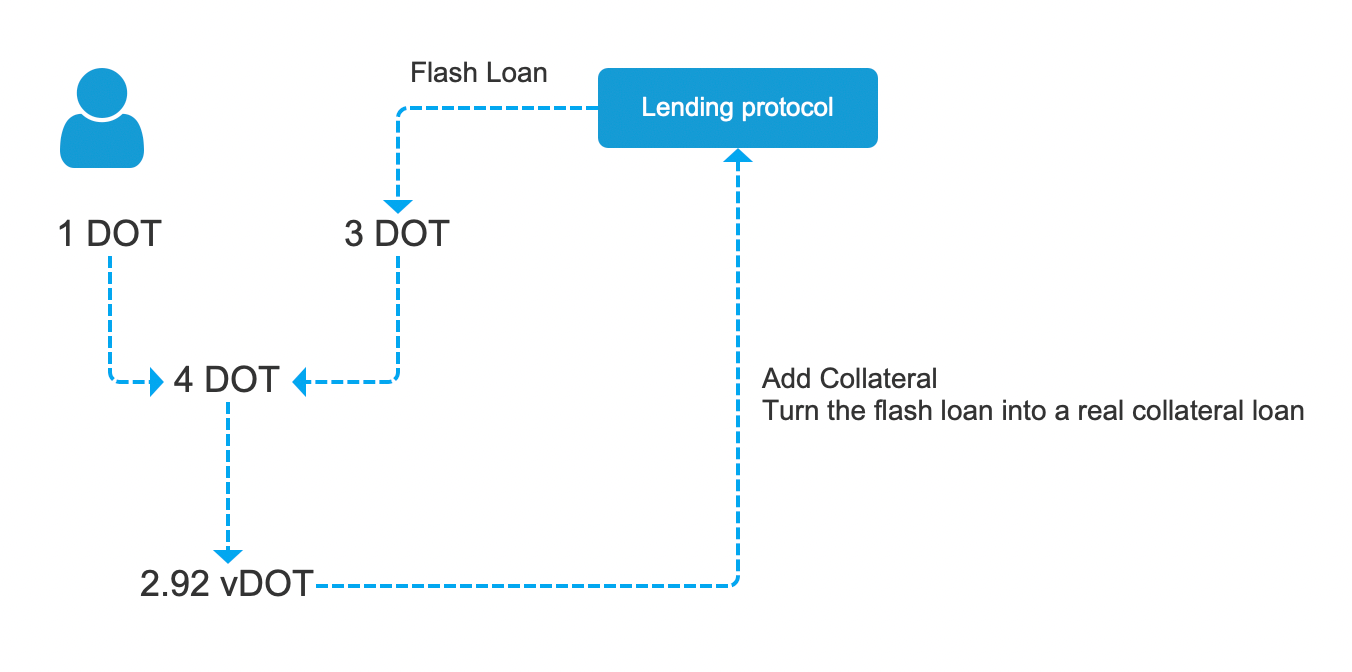Bifrost launches LoopStake - Supercharge your staking rewards through Leverage Staking
Liquid staking tokens (LSTs) have been present since the inception of the Proof of Stake (PoS) consensus mechanism. Since the Shanghai upgrade on Ethereum, LSTs have gained significant prominence, now representing the largest category within DeFi, with assets under management surpassing $60 billion.
Across various DeFi protocols, ETH LSTs are rapidly replacing ETH as a more versatile collateral option. This shift is attributed to Ethereum LSTs offering the market a yield-bearing asset. Consequently, many composability plays have emerged with LSTs as the foundational component for strategies and products - Leverage Staking serving as a prime example.
What is Leverage Staking
Leverage staking is a strategy that allows users to utilize LSTs on lending protocols to amplify the staking yield earned from these tokens. Users stake their assets to obtain an LST, use the LST as collateral on a lending protocol to borrow the staked assets, and obtain the LST again with the borrowed asset.
For instance, by collateralizing ETH to borrow stETH in AAVE, the over-collateralization rate stands at approximately 107%. This means that for every 1 ETH collateralized, users can borrow up to about 0.93 ETH worth of stETH. In contrast, if users were to collateralize ETH to borrow USDT, the over-collateralization rate could be as high as 130%. In this scenario, for every 1 ETH collateralized, users may only be able to borrow up to approximately 0.77 ETH worth of USDT.
This is because ETH/ETH-LST exhibits a strong price correlation. ETH-LST accumulates staking rewards, showing a one-way upward trend in ETH-based prices.
Leverage Staking is typically achieved through a manual looping process.
For example, if you are a user with 1 ETH:
- You can mint 1 ETH LST (assuming a minting rate of 1:1)
- Then, on a lending protocol, you collateralize 1 ETH-LST to borrow 0.93 ETH
- Next, you can mint the 0.93 ETH back into 0.93 ETH-LST
You can repeat this loop many times, boosting your yield. This, however, becomes unprofitable when the borrowing rate exceeds the staking yield.
As described above, the efficiency of manually conducting iterative staking operations is very low, and multiple transactions consume a lot of gas. Therefore, specialized leveraged staking management tools have emerged in the DeFi space, allowing users to complete leveraged staking within one single click.
Bifrost introduces LoopStake. A one-click leverage staking service tailored for the Polkadot ecosystem.
As a leading LST protocol in the Polkadot ecosystem, Bifrost’s LoopStake offers users a streamlined one-click leverage staking service designed explicitly for assets within the Polkadot ecosystem.
Manual leverage staking is possible, but it requires users to perform frequent manual operations and to transfer assets between parachains especially if the lending pool and LST protocol are not on the same parachain.
Users can access the LoopStake interface through Bifrost.app and enjoy the seamless leverage staking experience with just one click. The initial phase of the product launch will support leverage staking for assets such as DOT and KSM, and we will gradually expand to include more parachain assets.
Explore LoopStake directly on Bifrost dApp
LoopStake will allow users to set and manage leveraged ratios according to their risk preferences and leverage stake their assets with just one click. Behind the scenes, Bifrost directly creates leverage for users through flash loans, eliminating the need for iterative borrowing and reducing the number of transactions, resulting in lower gas costs.
Loop Stake features include a Leverage Up to 4x: LoopStake supports setting a maximum leverage ratio of 4x. With this feature, users can earn staking rewards on 4 times their initial deposits.
Basic users can simply liquid stake their DOT - obtaining vDOT - with an exchange rate of 0.73! According to the current incentive parameters of the Polkadot network, the annualized yield is approximately 22%, allowing you to earn +0.2 DOT a year per each single DOT staked.
If you are not satisfied with this yield, you can use leveraged staking!
Assuming you use 4x leverage, 1 DOT can be amplified to 4 DOT.
LoopStake allows this by borrowing 3 DOT through a flash loan and then staking the 4 DOT to mint 2.92 vDOT. After minting, vDOT will be placed in the collateral pool. You will earn staking rewards from the 2.92 vDOT while paying interest on the borrowed 3 DOT.
The final net yield is the actual yield you can receive.
Assuming a constant borrowing interest rate of 10%, the interest for borrowing 3 DOT over a year is 0.3 DOT. Initially, 2.92 vDOT can be redeemed for 4 DOT, and at the end of the year, it can be redeemed for 4.72 DOT (an increase due to accumulated staking rewards), resulting in a profit of 0.72 DOT. Comparatively, leveraging amplifies earnings by providing a significant increase compared to the 0.20 DOT earned without leveraging.
Aggregate Cross-chain Liquidity
Leverage staking requires access to the liquidity of lending pools.
Bifrost strives to aggregate cross-chain liquidity in the Polkadot ecosystem to provide leverage-staking users with the best borrowing rates. Leveraging Polkadot’s XCM messages and Bifrost’s Omni module, Bifrost’s LoopStake in the future will be able to access liquidity from lending pools on any other parachain.
However, considering that the increase in leverage staking volume is a process, in the initial stage of launching Loop Stake, we have opted to create a lending pool on Bifrost to provide lending liquidity, with plans to expand gradually.
Risks of Leverage Staking
Leverage staking involves amplifying risks to amplify returns. Thus, users should be cautious when opting into the product. Users will be exposed to more risks if they set a high leverage ratio.
Although the vToken/Token price ratio is quite stable and shows a one-way upward trend, in certain extreme circumstances, this price anchor may be impacted:
- Oracle Issues: Oracle price feeds may contain errors or be maliciously manipulated.
- Slash Risk: Malicious behavior by nodes or network failures may lead to slashing, resulting in decreased staking assets and a drop in vToken prices.
- Market Manipulation: Price fluctuations of vToken/Token may occur through large-scale buying and selling activities aimed at market manipulation.
- Code Risk: There may be code vulnerabilities in the leverage staking or SLP module.
To protect its users from these risks, Bifrost has implemented a series of measures to mitigate the issues highlighted above:
- Diversified Oracle Sources: Bifrost obtains price feeds from 4 different Oracle service providers, and any outliers from individual oracles are excluded.
- Slash Protection: Bifrost has implemented a systematic slash protection strategy, as detailed in the article “How Bifrost provides an insurance mechanism for vToken holders against the Slash risk.”
- Stable market-making system: The liquidity pool for vToken/Token utilizes a Stable Curve automated market-maker curve specifically designed for vToken, adjusting with the exchange rate of vToken/Token. Compared to traditional AMM market maker curves, its advantages lie in extremely low trading slippage costs and relatively stable exchange rate maintenance. Additionally, in the event of large transactions, MEV Bots will swiftly intervene to mitigate their impact on prices. Bifrost will operate a group of MEV bots, and any third party can also run arbitrage bots. For more details, please refer to “Bifrost LST Stable Swap”.
- Stringent Auditing Procedures: Loop Stake code has undergone an audit by a reputable auditing firm, Oak Security, and the audit report can be found HERE.
Nevertheless, we recommends that users fully understand the potential risks and set leverage ratios according to risk tolerance and profiles.
Conclusions
In DeFi, the emerging trend “Farming as a service” will become popular.
DeFi protocols will provide a single source of income and offer users a range of combined yield strategies, allowing users to access multiple sources of income with a single click.
This model will simplify user operations, provide users with higher capital efficiency, and offer more flexible choices. Staking is just the beginning, and in the future, Bifrost will introduce more combined yield strategies to expand the choices available to vToken holders further.
Just as Loop Stake allows for remote access to multi-chain lending pools, our combined yield strategies will not be limited to single-chain strategies but can fully leverage the entire DeFi ecosystem to create cross-chain combined strategies.
Bifrost’s research and exploration in chain abstraction and full-chain architecture have already provided sufficient support for us to achieve this.
Bifrost Community Lead
Bifrost is a Liquid Staking app-chain tailored for all blockchains, utilizing decentralized cross-chain interoperability to empower users to earn staking rewards and DeFi yields with flexibility, liquidity, and high security across multiple chains.




5 comments